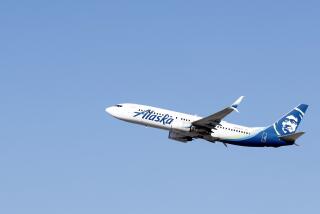FAA Adopts New Rules to Track Metal Fatigue on Boeing Jetliners
WASHINGTON — The Federal Aviation Administration imposed rules Tuesday for preventing fatigue damage in aging Boeing airliners, and proposed rules for detecting corrosion in the planes.
The fatigue rules require replacement of some parts when an airliner reaches a set number of flights, while the corrosion rules call for periodic inspections of all Boeing 707, 727, 737 and 747 airliners as they age.
Fatigue rules were proposed last May after a task force of U.S. and foreign airlines drew up plans for ensuring that the world’s aging airline fleet can keep flying safely. Foreign regulatory agencies generally follow FAA requirements for U.S.-built planes.
The effort was started after the roof of an Aloha Airlines 737 ripped off at 24,000 feet over Maui, Hawaii, in April, 1988. A stewardess was swept to her death and 64 passengers were injured.
That accident was caused primarily by metal fatigue, but corrosion also was found, the FAA reported. The plane was 19 years old with nearly 90,000 flights.
The new fatigue rules, which take effect in 30 days, give airlines four years to comply with all of the requirements and will immediately affect 115 older, U.S.-registered Boeing aircraft. The estimated cost to airlines, which have done some of the required work, is $142 million over the first four years.
Planes affected have already passed their original economic design life. But Tony Broderick, FAA regulations chief, said the agency believes that if the regulations are followed, there will be no need to retire airliners at a given age.
Final fatigue rules for McDonnell Douglas airliners are to be issued in a couple of months, with rules for other airliners to be issued before the end of the year.
More to Read
Inside the business of entertainment
The Wide Shot brings you news, analysis and insights on everything from streaming wars to production — and what it all means for the future.
You may occasionally receive promotional content from the Los Angeles Times.










